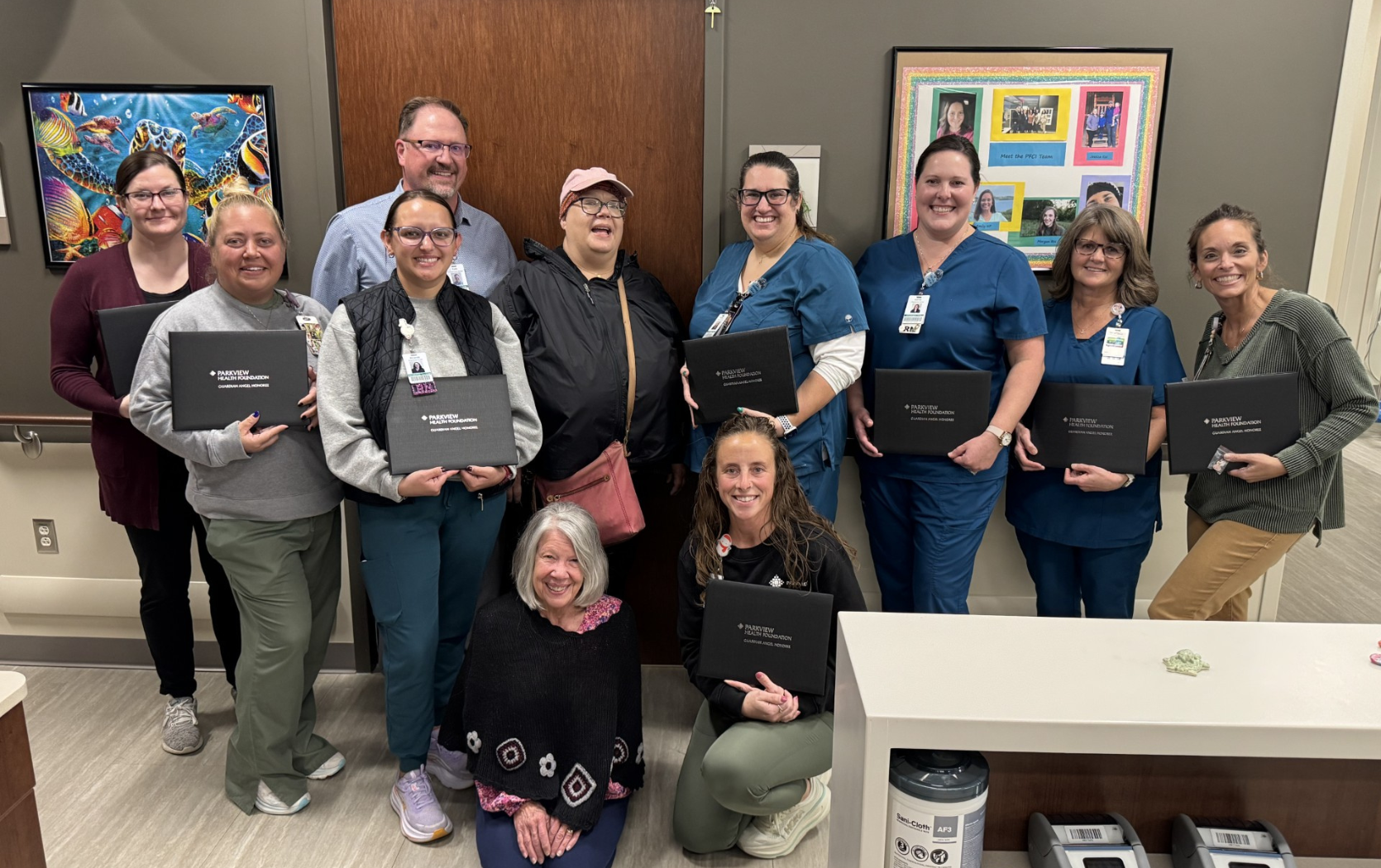
It started a few years ago, when Jon Dettmer, DPT, SCS, COMT, and Ryan Nelson, DPT, CSCS, SCS, COMT, athletic rehab physical therapists based out of the SportONE Parkview Fieldhouse reached out with a curiosity. “They had been using blood flow restriction for some time with their athletes, and wondered if the approach would have any benefit for neurological physical therapy patients,” Nicole Walter, MPT, CSRS, CBIS, recalled.
As a Board-Certified Clinical Specialist in Neurologic Physical Therapy and site coordinator for clinical education at Parkview Outpatient Therapy at Parkview Hospital Randallia, Nicole was interested in the potential for a number of reasons. “We have a Neurologic Physical Therapy Resident, Colin Lelito [PT, DPT], here, and part of the requirements for completing his residency is to do research. So, the guys came over from the Fieldhouse and we talked about their experiences using blood flow restriction. They showed us some things and we started learning about the modality,” Nicole said.
The top priority and consideration for Nicole and Colin was the safety of introducing a new approach with the neuro trauma population. “We both work with patients who have had some degree of neurological trauma. Colin sees patients while they are in the hospital, and I see them in an outpatient setting. These would be individuals who have had a stroke, traumatic brain injury, or spinal cord injury. Our goal is always to get people as close to their pre-event normal as we can, which is tricky, because that isn’t always realistic. Any tool that can help with their progress, we’re willing to explore. But when I started looking into the literature, there just wasn’t a lot out there. Overall, the studies I found indicated that it was safe, just not utilized much.”
The science behind the modality
Blood flow restriction (BFR) works by using a specially designed tourniquet hooked up to a unit to reduce arterial inflow and occlude venous outflow. It is believed to accelerate muscle recovery and prevent atrophy. “We can use BFR to help our patients reach a level of maximum exercise that they can’t get on their own,” Nicole explained. “It facilitates the same result as a maximum muscle contraction or strengthening exercise.” And for neurological rehab patients, that can be the differentiator that gives them their independence.
Putting BFR into practice
Once she felt comfortable with the safety of BFR, it became a matter of application. “About two years ago, I had a patient who was fairly young and in good shape prior to a spinal cord injury,” she said. “In rehab, the goal is to get the patient walking again, and we decided to try BFR. The results were impressive, so we continued.”
For Colin, pairing BFR with another modality became the standard. “While in my four-month inpatient rehab rotation at Randallia, I made BFR with robot-assisted gait training the primary treatment plan for three patients,” Colin said. “All three had suffered strokes and, as a result, were left with a hemiparetic limb or a limb that didn’t move well as a result of weakness. We saw significant improvements in their ability to complete transfers and walk with less physical assistance. Even with a smaller sample size, we saw different results based off many different variables – location of stroke, premorbid health, demographics, adverse medical events during admission, support at discharge, etc. Despite all these variables, each patient demonstrated significant improvements in their own ways. There also could have been carryover into their speech and occupational therapy as a result of the intervention that we didn’t capture.”
Sharing results
Since 2020, Nicole and Colin have used BFR in a number of cases, with predominantly positive results. “We had one situation in which I was treating a gentleman for a spinal cord injury and, while he was receiving outpatient therapy, his wife had a stroke. She was young and a triathlete. She requested BFR while she was inpatient. I couldn’t find anything in the literature about BFR at that level of care. I shared the lack of research with her, and she told me she wasn’t going to get any worse. She’d been watching how it benefited her husband and she wanted to do it.”
This prompted Colin to document what the pair had already been seeing. “I decided to do the first formal case study on BFR with this patient when she was admitted to inpatient rehab in November 2022. Her case stands out to me the most. On admission, she required assistance from two people – one person supporting her trunk, and one person supporting her left leg with the use of a hemi-rail for her to hold on to – to walk about 10 feet. By the end of her 16-day admission, she was walking with a walker with supervision-level assist, meaning I was just there watching her. She went from requiring significant physical assistance to get out of bed and into a chair to being able to do it on her own. In inpatient rehab, one of our main objectives is to facilitate safe discharge, which we accomplished.”
The modality moved with the patient as she graduated to the next level of care. “I continued BFR when she transitioned to outpatient rehab. Her progress has inspired me and gotten me excited about how the therapy can help others,” Nicole said.
The future of BFR for neurological physical therapy
“The Neurological Physical Therapy Residency at Parkview has afforded me so many great opportunities – both as a clinician and a person,” Colin said. “My mentors push me every day to be better and to continue using the best evidence-based practices available in order to provide the highest quality of care to my patients. All credit for sparking this idea goes to Nicole Walter. I think the biggest difference with being a resident is having the availability and support to learn and be involved with new techniques such as this. The use of BFR with robot-assisted gait training is a rather time-intensive activity, and I would not have been able to accomplish what I did without the help of my rehab mentors – Alyssa Keys, Coleen Harmon and Ross Nelson – and support from rehab management–Chris Rakoczy, Tafara Masarira and Gabbe Nix. When completed a preliminary literature review of the use of BFR within the neuro population, there wasn’t much there. Being among the first to implement this and receive positive results is pretty awesome.
“While I think more research is needed to fully explore the efficacy of BFR for the neuro population, in the brief encounters that I have had with BFR, I have had nothing but positive experiences and outcomes. The patients notice the results, too.”
Collaboration seems to be the special sauce when it comes to fresh approaches to faster healing. “The nice thing about physical therapy at Parkview is that there’s open communication between the teams in the different specialties. Sharing that knowledge only improves the care we can provide to all of our patients,” Nicole said.
Colin couldn’t agree more. “I think the more we can examine the utility of BFR across the continuum of care, from ICU to speech and occupational therapy, the better we can understand how to apply it to give our patients the best outcomes possible. Support to introduce new modalities and techniques like this, just advances the professions of physical, occupational and speech therapy.” And that’s exciting for all involved.



